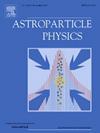Characterization and absolute calibration of R11265 multi-anode photomultiplier tubes for the JEM-EUSO space and balloon program: II. Application to the EUSO-SPB2 photodetection modules
IF 2.9
3区 物理与天体物理
Q1 ASTRONOMY & ASTROPHYSICS
引用次数: 0
Abstract
The fluorescence camera of the EUSO-SPB2 mission is the last and most advanced implementation of the technology developed within the JEM-EUSO (Joint Exploratory Missions for an Extreme Universe Space Observatory) collaboration to study ultra-high-energy cosmic rays (UHECRs), extensive atmospheric showers and transient luminous events from space. It consists of three photodetection modules, each hosting nine elementary cells with 36 multi-anode photomultiplier tubes (MAPMTs), for a total of 6912 pixels. The associated electronics was designed to operate in single photon counting mode. In this paper, we apply the calibration techniques presented in the accompanying paper (Paper I) to characterize the photodetectors of the EUSO-SPB2 fluorescence camera. In particular, we determine the photodetection efficiency and physical size of each pixel. We find an average efficiency of 32%. We also examine its dependence with high voltage and photon wavelength, and determine the double pulse resolution of the different channels, of the order of 10 ns.
用于JEM-EUSO航天和气球项目的R11265多阳极光电倍增管的表征和绝对校准:2。应用于EUSO-SPB2光检测模块
EUSO-SPB2任务的荧光相机是JEM-EUSO(极端宇宙空间天文台联合探索任务)合作开发的技术的最后和最先进的实现,用于研究超高能宇宙射线(uhecr),广泛的大气淋浴和来自太空的瞬态发光事件。它由三个光电探测模块组成,每个模块包含9个基本单元和36个多阳极光电倍增管(MAPMTs),总计6912像素。相关的电子器件被设计成在单光子计数模式下工作。在本文中,我们应用所附论文(论文I)中提出的校准技术来表征EUSO-SPB2荧光相机的光电探测器。特别是,我们确定了光探测效率和每个像素的物理尺寸。我们发现平均效率约为32%。我们还研究了它与高电压和光子波长的关系,并确定了不同通道的双脉冲分辨率,约为10 ns。
本文章由计算机程序翻译,如有差异,请以英文原文为准。
求助全文
约1分钟内获得全文
求助全文
来源期刊

Astroparticle Physics
地学天文-天文与天体物理
CiteScore
8.00
自引率
2.90%
发文量
41
审稿时长
79 days
期刊介绍:
Astroparticle Physics publishes experimental and theoretical research papers in the interacting fields of Cosmic Ray Physics, Astronomy and Astrophysics, Cosmology and Particle Physics focusing on new developments in the following areas: High-energy cosmic-ray physics and astrophysics; Particle cosmology; Particle astrophysics; Related astrophysics: supernova, AGN, cosmic abundances, dark matter etc.; Gravitational waves; High-energy, VHE and UHE gamma-ray astronomy; High- and low-energy neutrino astronomy; Instrumentation and detector developments related to the above-mentioned fields.
 求助内容:
求助内容: 应助结果提醒方式:
应助结果提醒方式:


